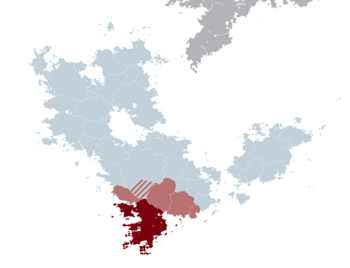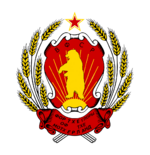Vogria
This article is incomplete because it is pending further input from participants, or it is a work-in-progress by one author. Please comment on this article's talk page to share your input, comments and questions. Note: To contribute to this article, you may need to seek help from the author(s) of this page. |
Vogrian Federative Socialist Republic Вогрианскаыа Федеративнаыа Сотсиалистическаыа Республика Vogrianskaya Federativnaya Sotsialisticheskaya Respublika (Vogrian)) | |
|---|---|
| Motto: Фор тхе глоры оф тхе Мотхерланд! (Vogrian)
"For the Glory of the Motherland!" | |
| Anthem: Тхе Ред Баннер Марчес Тоwард тхе Футуре (Vogrian) The Red Banner Marches Toward the Future | |
 Vogria (red) and its satellite republics (lighter red) on the continent of Aslaria (light blue). | |
| Capital | Yarolavka |
| Largest city | Mikhailgrad |
| Official languages | |
| Recognised regional languages | |
| Ethnic groups (2016) |
|
| Religion | |
| Demonym(s) | Vogrian |
| Government | Federal One-Party Socialist Republic |
• Premier | Vasili Danilovich |
| Semyonov Fyodorovich | |
| Komolov Georgiy | |
| Legislature | Federal Diet |
| Supreme Chamber of the Republics | |
| Congress of People's Deputies | |
| Establishment | |
• Red Guard Revolution | October 27th, 1925 |
• Civil War Ended | August 15th, 1928 |
• First Constitution | September 30th, 1928 |
• Involvement in the War of Krumaarian Succession | July 24th, 1942 |
• Reforms of Mikhail Loriv | December 26th, 1987 |
• Second Constitution | January 30th, 1989 |
| Area | |
• Total | 1,930,254 km2 (745,275 sq mi) |
• Water (%) | 23.7 |
| Population | |
• November 2020 estimate | 150,201,651 |
• 2015 census | 147,750,835 |
• Density | 11.9/km2 (30.8/sq mi) |
| GDP (PPP) | 2013 estimate |
• Total | $2.45 trillion |
• Per capita | $19,740 |
| GDP (nominal) | 2016 estimate |
• Total | $2.45 trillion |
• Per capita | $16,100 |
| Gini (2016) | 25.6 low |
| HDI (2018) | very high |
| Currency | Vogrian Ruble (₽) (VOR) |
| Time zone | UTC+3 (AET) |
| Driving side | right |
| Calling code | (+ 26) |
| ISO 3166 code | VOG |
| Internet TLD | .vg |
The Vogrian Federative Socialist Republic (Vogrian FSR or VFSR; Vogrian: Вогрианскаыа Федеративнаыа Сотсиалистическаыа Республика, tr. Vogrianskaya Federativnaya Sotsialisticheskaya Respublika), commonly referred to as Vogrian FSR, Vogrian Federation, or simply Vogria, is an independent federal one-party socialist state located on the continent of Aslaria. The Vogrian FSR is composed of five smaller constituent units of autonomous republics, and 2 autonomous oblasts. Vogrians form the largest ethnic group. The capital of the Vogrian FSR is Yarolavka and the other major urban centers include Mikhailgrad, Voroborg, Podoturynisk, Kiriprudny and Chernosnovy.
The Vogrian FSR was established in the midst of the Red Guard Revolution of 1925 when the Red Guards led by Nikolai Voroshilov overthrew the monarchy of the Kingdom of Vogria. They established the Vogrian People's Republic, beginning a civil war between the VPR's Red Army and a coalition of anti-Communist forces pulled from across the former Kingdom, among who the largest faction was the Royal Guard. The Red Army expanded it's hold throughout most of the Kingdom, assisting local peasant uprisings while suppressing political opponents and Royal loyalists through the means of the Red Terror. By 1928, the VPR had emerged victorious, establishing the formation of the Vogrian Federative Socialist Republic with the unification of the Vogrian, Kossacki, and Bulgrinovan republics.
Between 1929 and 1939, Vogria went through a period of rapid industrialization and forced collectivization that led to siginificant economic growth, but also led to an increase in forced labor camps populated by political dissidents, and those deemed unfaithful to the socialist system. A man-made famine in 1934-1935 saw the deaths of hundred of thousands of Kossacki citizens, creating anamosity between Kossacki citizens and the Communist government. On the eve of the War of Krumaarian Succession, Vogria had rose as an industrial powerhouse, becoming the 4th largest economy in the Western Hemisphere.
Throughout the 1950's and 60's, Vogria continued to develop at a steady pace as millions of peasants were relocated to the various industrialized centers in the Federation in period of rapid urban resettlement. In 1967, Vogria supported the creation of a socialist state within the Taijud People's Democratic Republic, creating tensions between Vogria and the Sanctified Republic of Veltria. In the mid-1980s, Mikhail Loriv sought to reform and liberalize the economy of Vogria. This program known as the Economic Reform Iniative saw the transition of the economy from a planned centralized economy with an increasingly open-market economy. Vogria adopted its current constituiton in January of 1989 formalizing the new economic transition as a well as a swathe of political reforms which includes the creation of the Congress of People's Deputies which would represent the will of the people and act as the new lower house of the Federal Diet.
As of 2020, Vogria is a member of the Phaegian Economic Community, the Undrian Regional Council, and is one of the founding members of the Council for Mutual Economic Assistance (formed in 1953 as an economic organization between the various socialist states throughout Undria). Vogria is a recognised nuclear weapons state and is fourth in military expenditure in the world. Vogria's vast mineral and energy resources makes it one of the world's leading producers of offshore oil and natural gas. As the leading socialist state in Phaegia, Vogria has lended aid to various developing nations and has assisted in the prompting up of socialists regimes throughout the continent.
Etymology
History
Geography
Demographics
Politics
There are three power hierarchies in Vogria: the legislature represented by the Federal Diet of the Socialist Republic, the government represented by the Council of Ministers, and the Communist Party of Vogria (CPV), the only legal party and the final policymaker in the country.
Communist Party
The Communist Party maintain its dominance over the state mainly through its control over the system of appointments. All senior government officials and most deputies of the Federal Diet are members of the CPV. At the top of the Communist Party is the Executive Committee, elected at the Supreme Chamber of the Republics. In turn the Executive Committee voted for a Politburo, General Secretary, and Premier, which was largely cermonious. Depending on the degree of power consolidation, it was either the Politburo as a collective body or the General Secretary, who always was one of the Politburo members, that effectively led the party and the country. However after 1990, more power was transitioned over to the Premier developing as an independent executive office, with the General Secretary transitioning over to become the de facto head of the Federal Diet. The current Premier, Vasili Danilovich was elected into office as of 2018 with the current General Secretary, Boris Turgenev, being appointed in 2020.
Government
The Federal Diet (successor of the Supreme Congress of Liberated Workers) is the highest state body in Vogria, at first acting as a rubber stamp institution, approving and implementing all decisions made by the party. However, its powers and functions were extended in the late 1950s, 1960s and 1970s, including the creation of new state commissions and committees. It gained additional powers relating to the approval of multiple Five-Year Plans and the government budget. The Federal Diet elected a Presidium (successor of the Central Executive Committee) to wield its power between plenary sessions, ordinarily held twice a year, and appointed the Supreme Court, the Procurator General and the Council of Ministers, headed by the Chairman (Premier) and managing an enormous bureaucracy responsible for the administration of the economy and society. State and party structures of the constituent republics largely emulated the structure of the central institutions. Local authorities were organized likewise into party committees, local Congresses and executive committees. While the state system was nominally federal, the party was unitary.
The state security police (the KVB and its predecessor agencies) played an important role in Vogrian politics. Under Gregori Preobrazhensky, the KVB engaged in the suppression of political dissent and maintained an extensive network of informers, reasserting itself as a political actor to some extent independent of the party-state structure, culminating in the anti-corruption campaign targeting high-ranking party officials in the late 1970s and into the 1990s.
Foreign Policy
In the aftermath of the War of Krumaarian Succession, Vogria adopted a policy of ideological expansion throughout most of the 1950s. By the beginning of the 1960s however, Vogria became a major force in supporting anti-imperialist movements throughout most of Aslaria. In 1962 Vogria established the Aslarian Mutual Defense League (AMDL), the military complement to the Council for Mutual Economic Assistance (CMEA) that was established in 1952 as a regional economic organization for the socialist states of Aslaria. The League was created in reaction to growing hostility between Vogria and the Sacitified Republic of Veltria and its allies in northern Aslaria, who created their own military alliance, the Akkria Mutual Assistance Pact.
In 1967, Vogria helped prompt the establishment of several socialist states along its northern border in order to create a buffer zone between it and Veltra, while also expanding its political sphere and regional influence. These nations, while technically autonomous under international law, report directly to Yarolavka in cases of economic assitances via trade, military organization, foreign relations, political party structure, and technology sharing. Vogria has used military force to crackdown on political instability within these nations multiple times throughout the 1970s during the Student Revolutions, a youth led insurrection that sparked across most of the socialist states within Asalria, prompting Vogria to blame Veltria for sponsering revolutionary movements within its sphere.
Military
Under the Military Formation Law of 1928, the Vogrian Armed Forces consisted of three main branches, namely the Land Forces, the Air Force, and the Navy, along with the creation of the Troops of the Interior, and the People's Commissar Directorate (PCD). In 1933, the Troops of the Interior and the PCD became independent of the Armed Forces and in 1935 were merged with the People's Commissariat of Internal Security. After the War of Krumaarian Succession, the Strategic Missile Command Forces(1962) and Federal Civil Defense Forces (1965) were established.
As of 2020, the military consisted of an estimate 475,000 active duty personnel; additionally there are over 750,000 reservists across all military branches. It is mandatory for all male citizens aged 18-28 to be drafted for a year of service in the Armed Forces.
The nation has a large and fully indigenious arms industry, producing most of its own military equipment while importing only limited quantities of foreign equipment. Vogria has been one of the world's major suppliers of arms since 2007, accounting for nearly 20% of worldwide weapon sales and exporting weapons and equipment to a multitude of nations throughout Phaegia and Undria. This is seconded only by Veltria and the Latin Empire of Great Bunter
The Vogrian government's official 2018 military budget is about 1.5 trillion rubles, the fourth largest in the world. The official budget is set to increase to 2.25 trillion rubles in 2019, and 3.05 trillion rubles by 2020. However unofficial reports state that the budget could be significantly higher putting the Vogrian military at a budget rivaling that of Veltria, making it the second most powerful military on Phaegia.
Education
Economy
Culture
WIP




